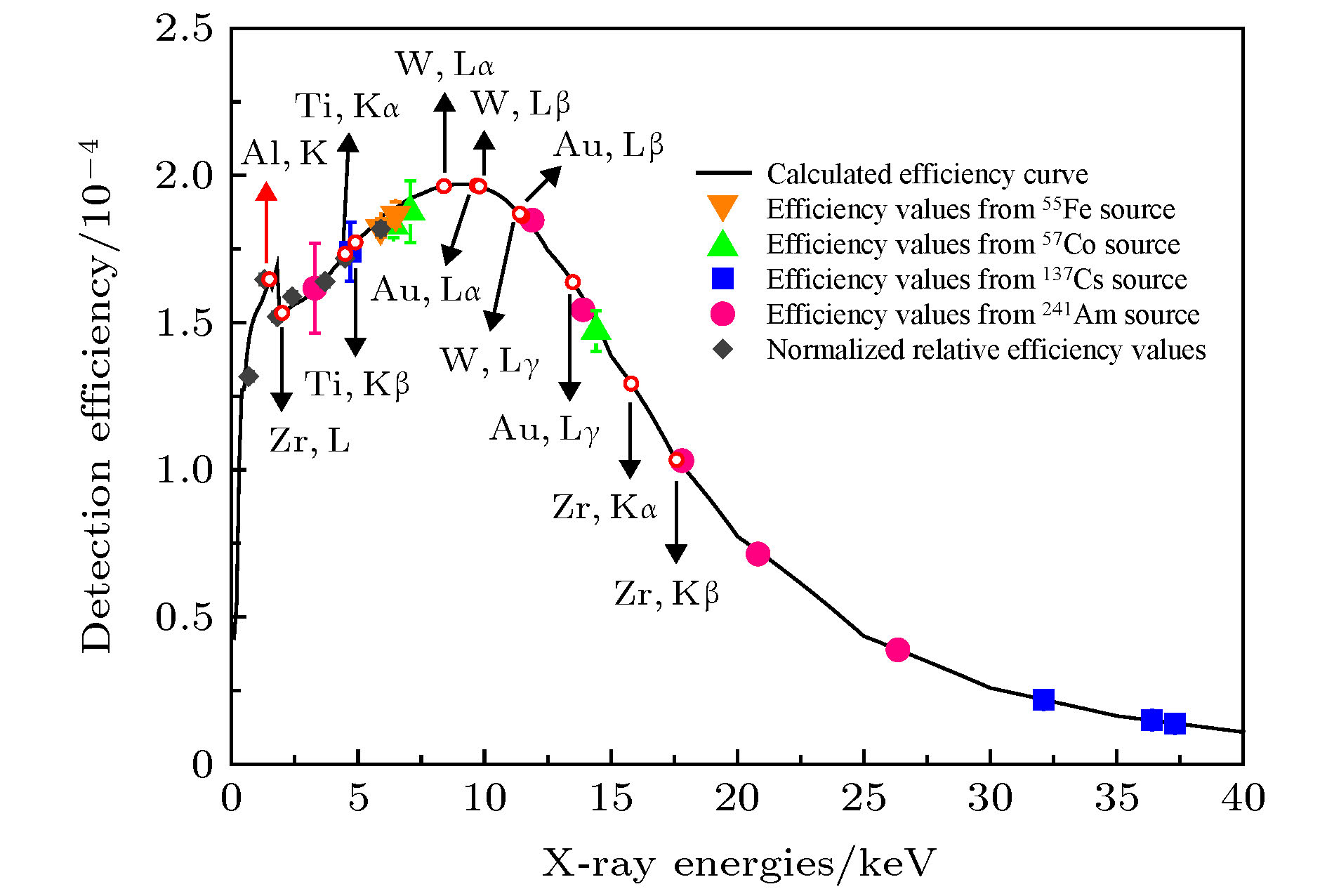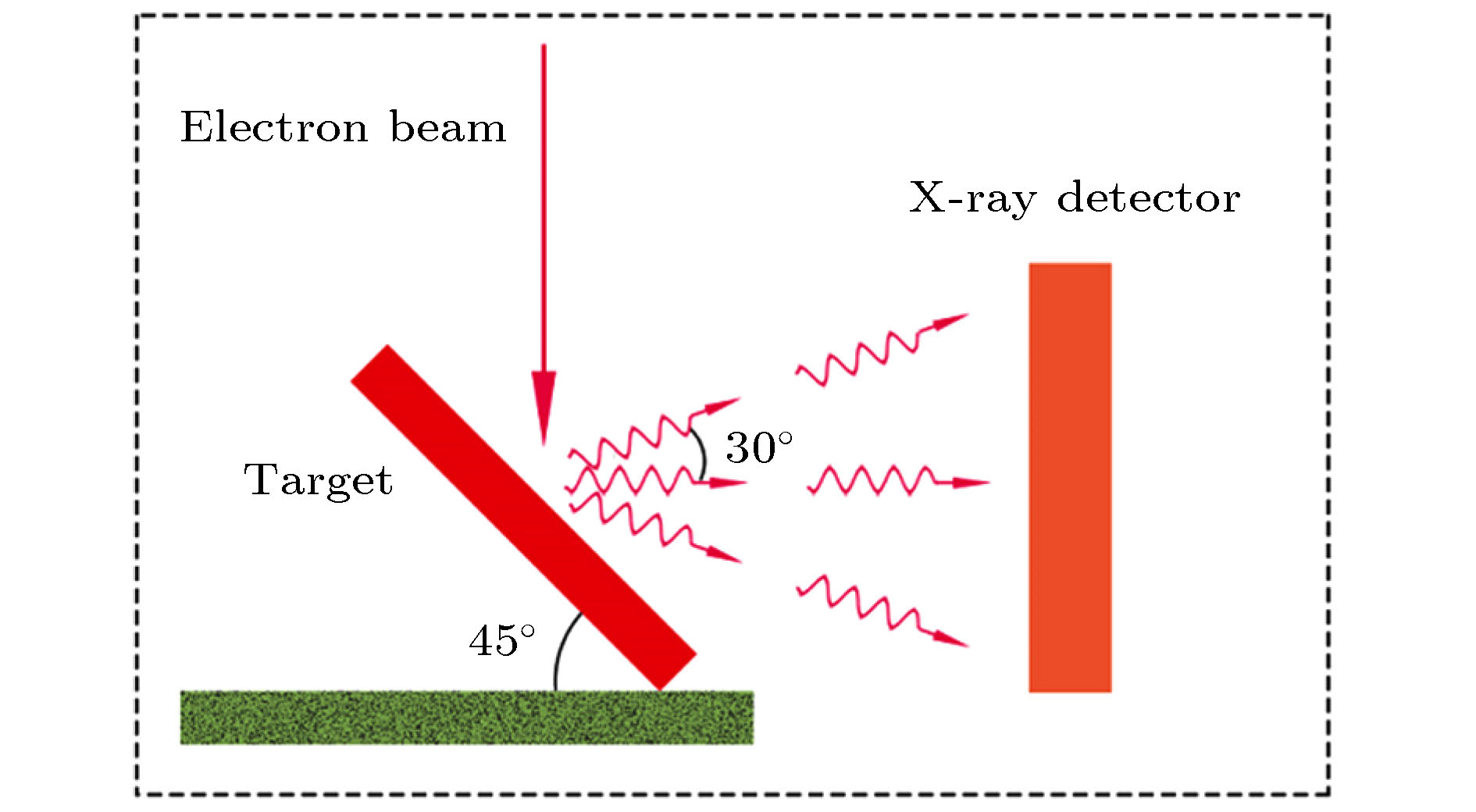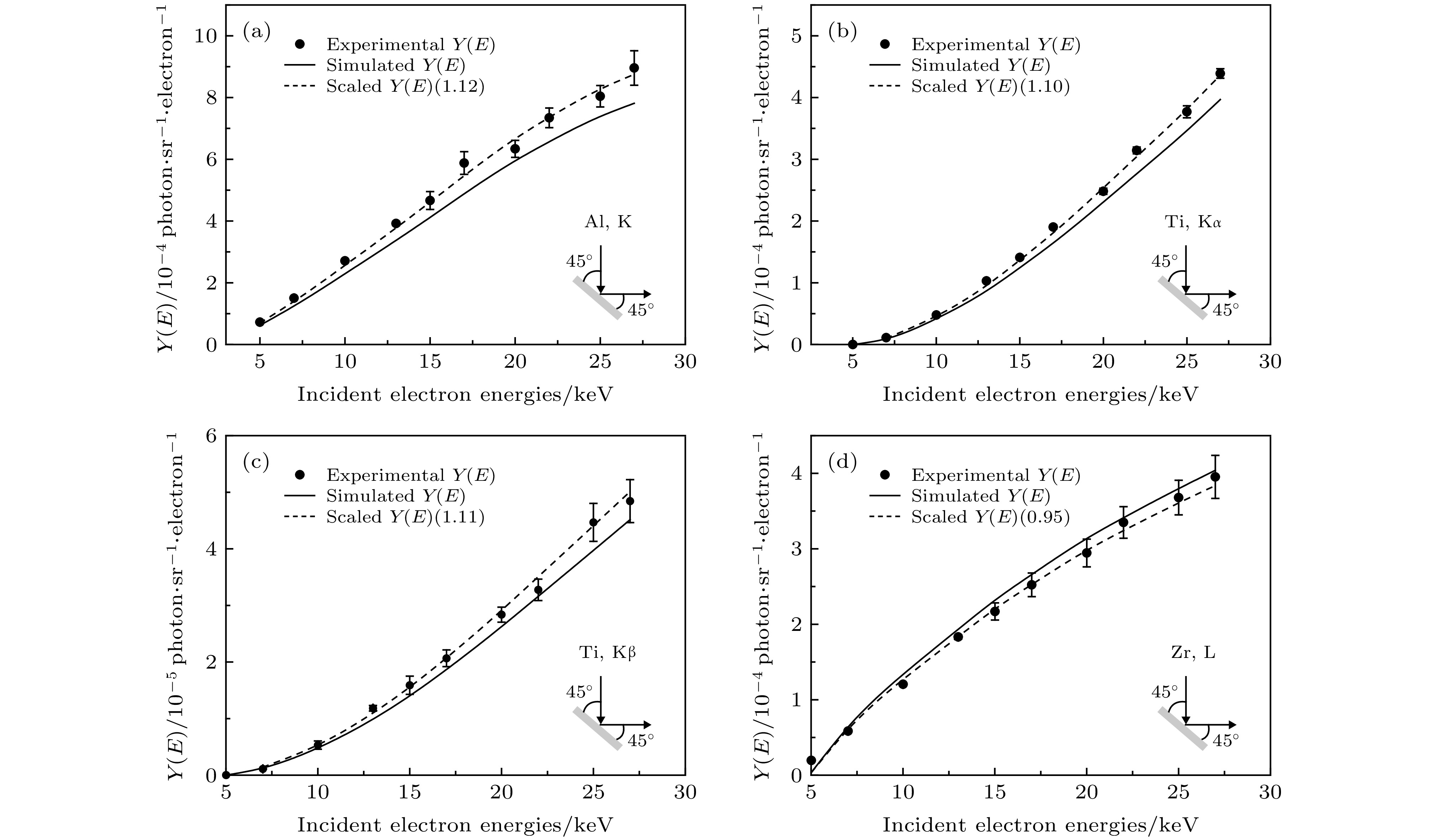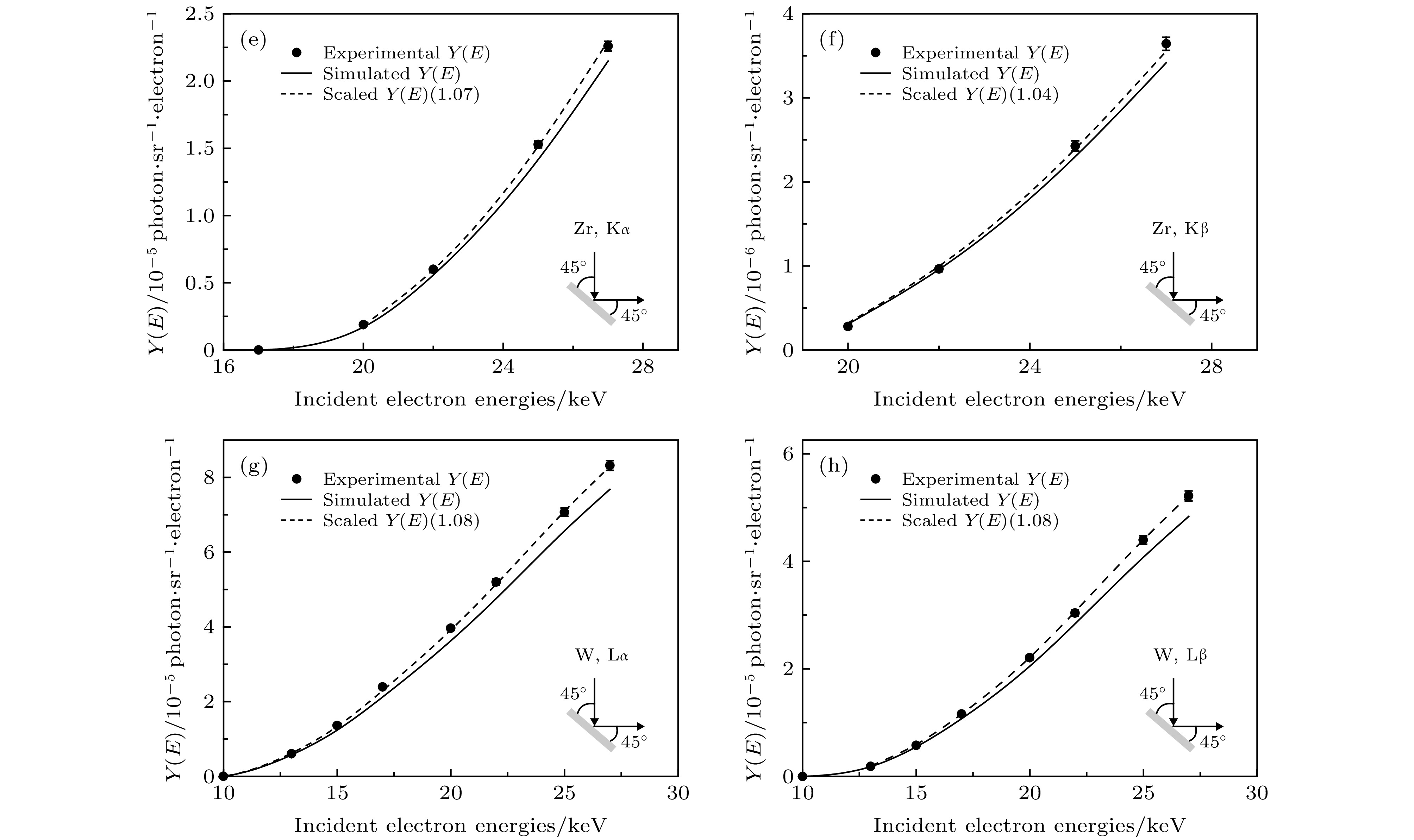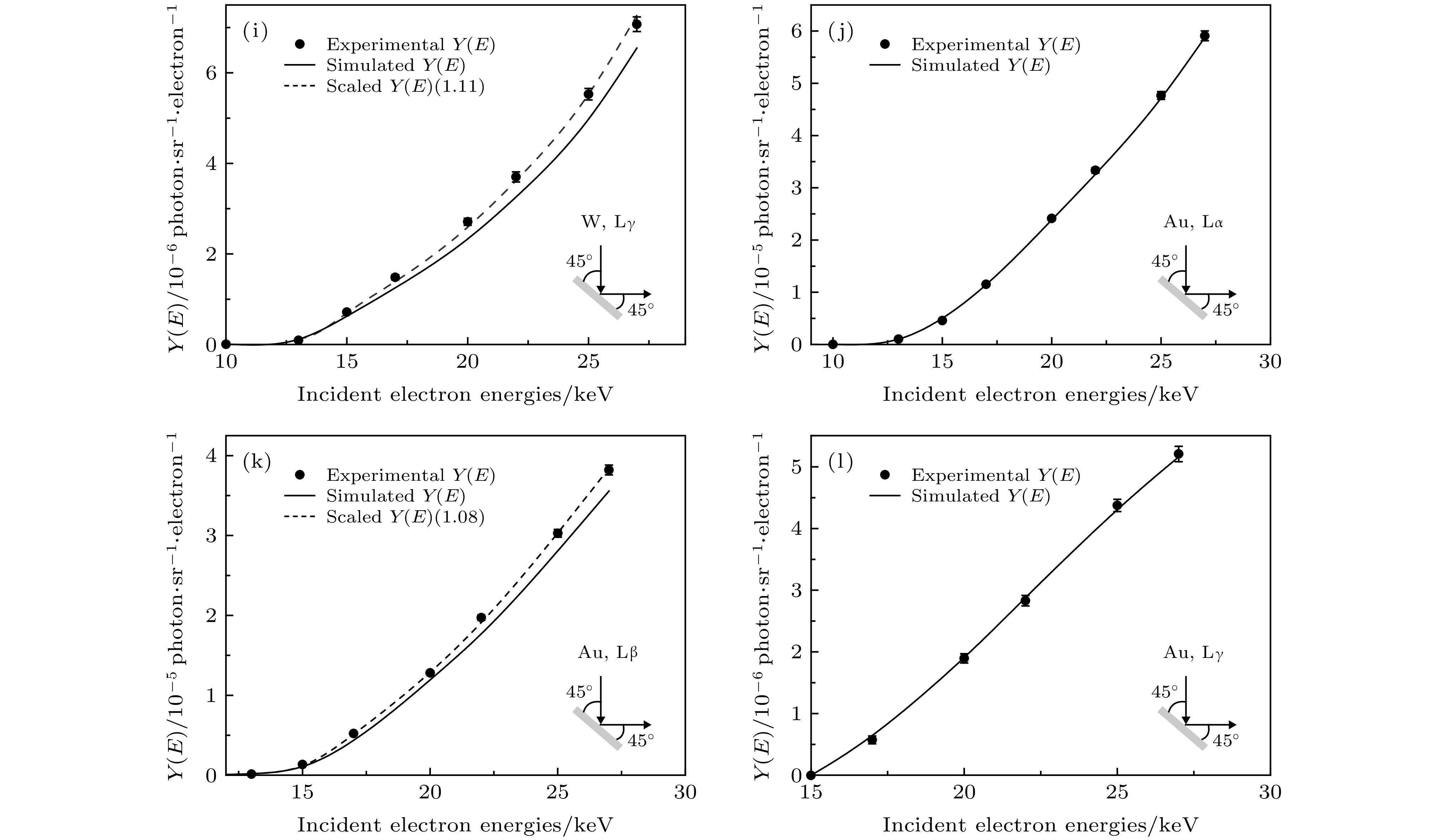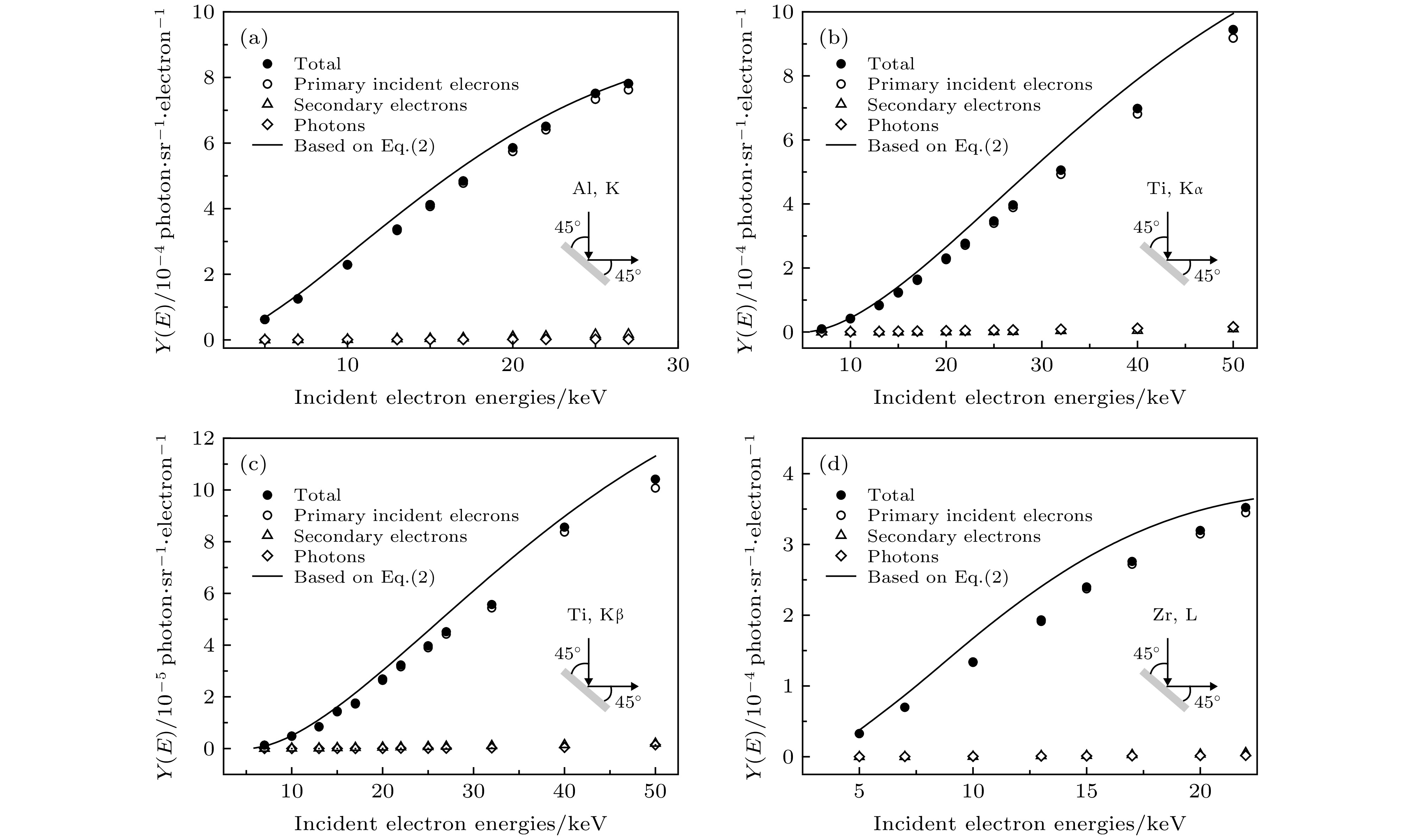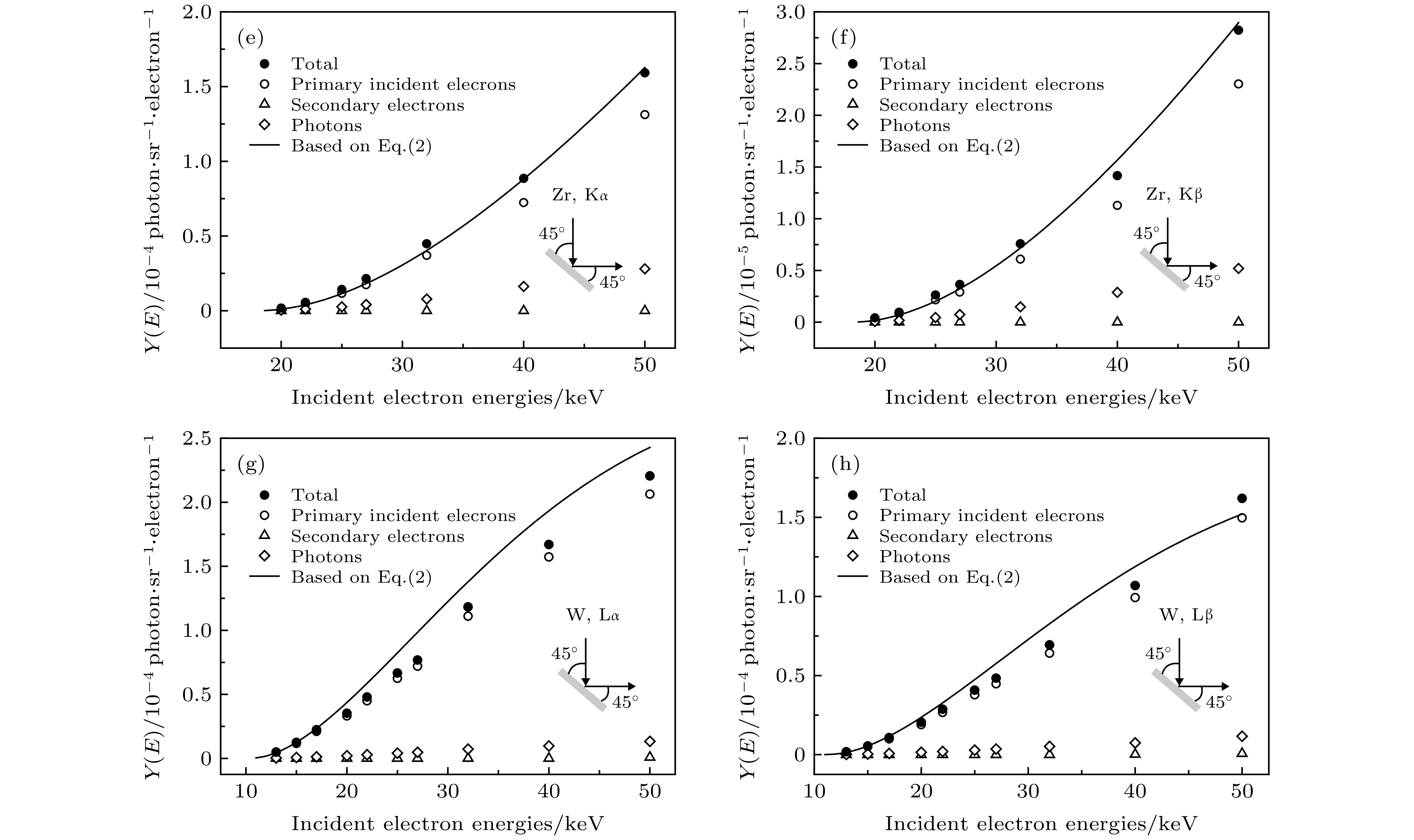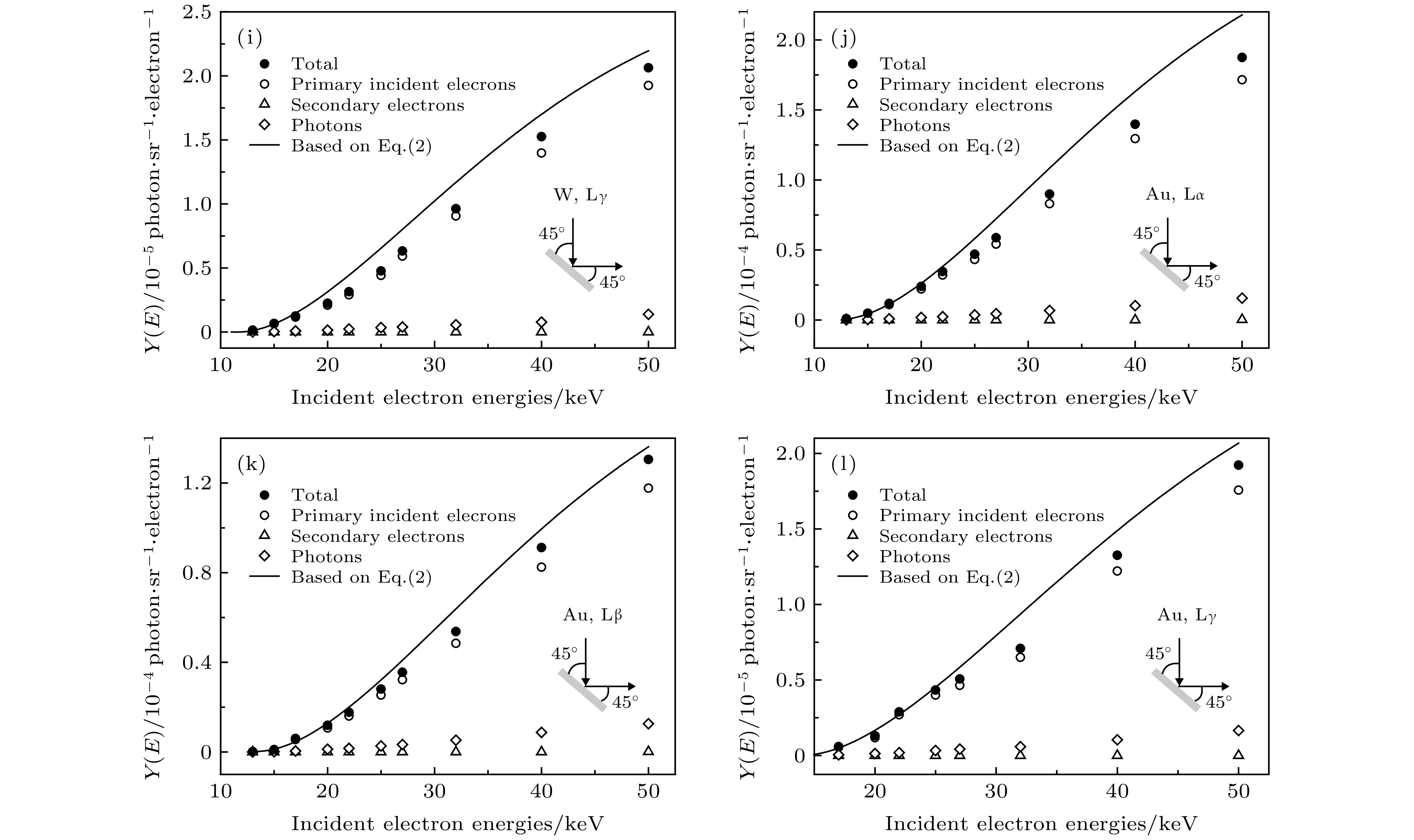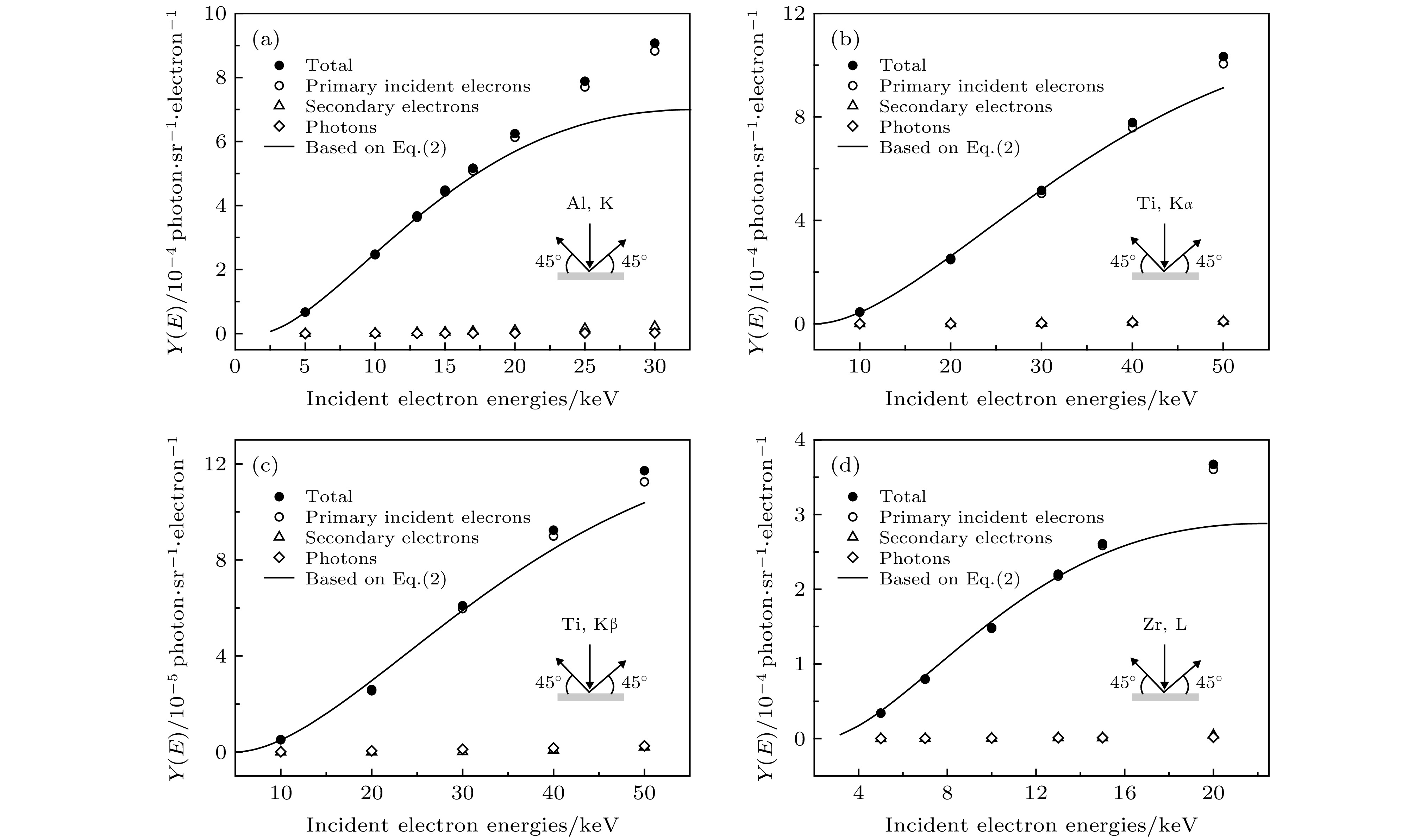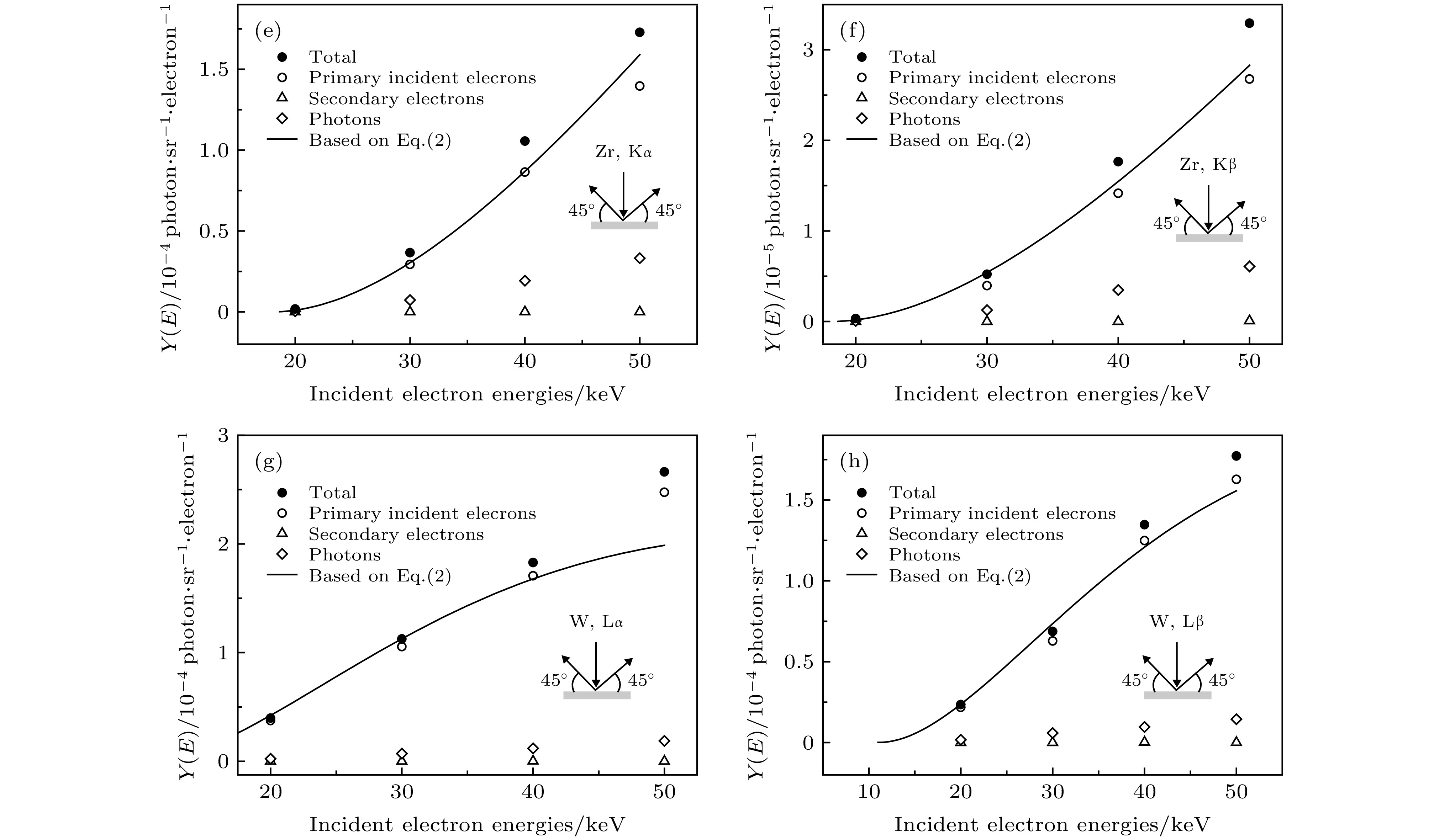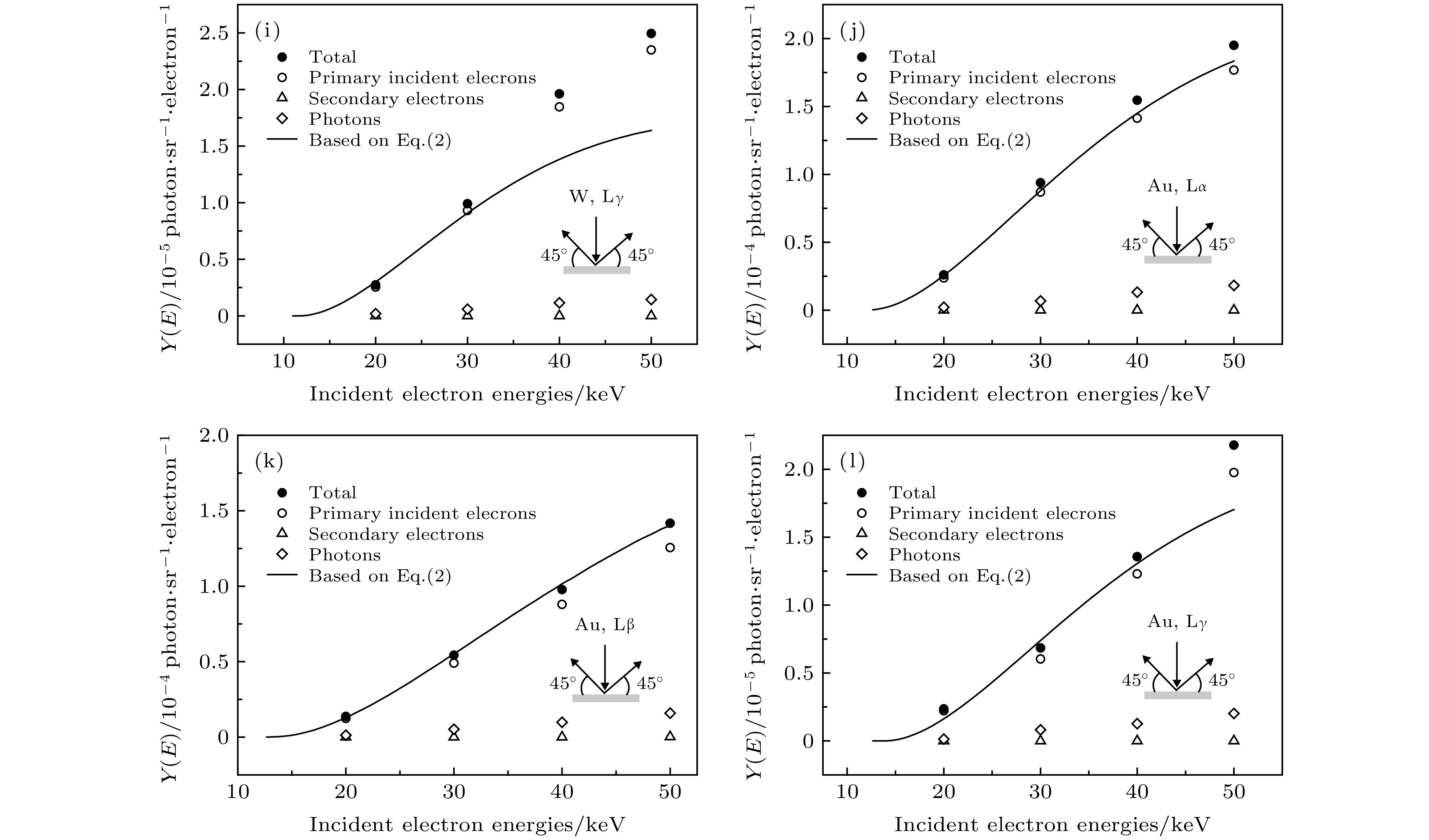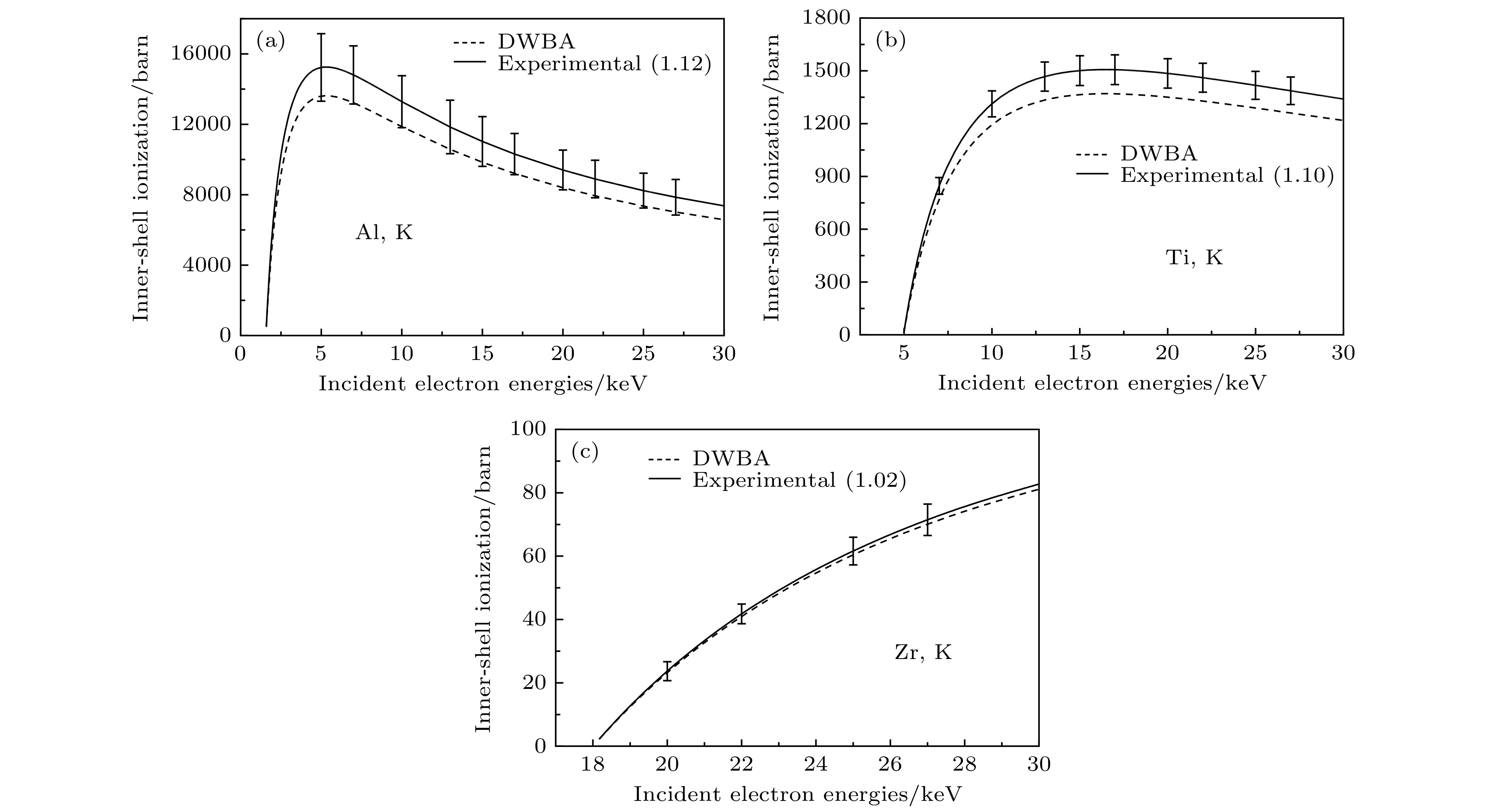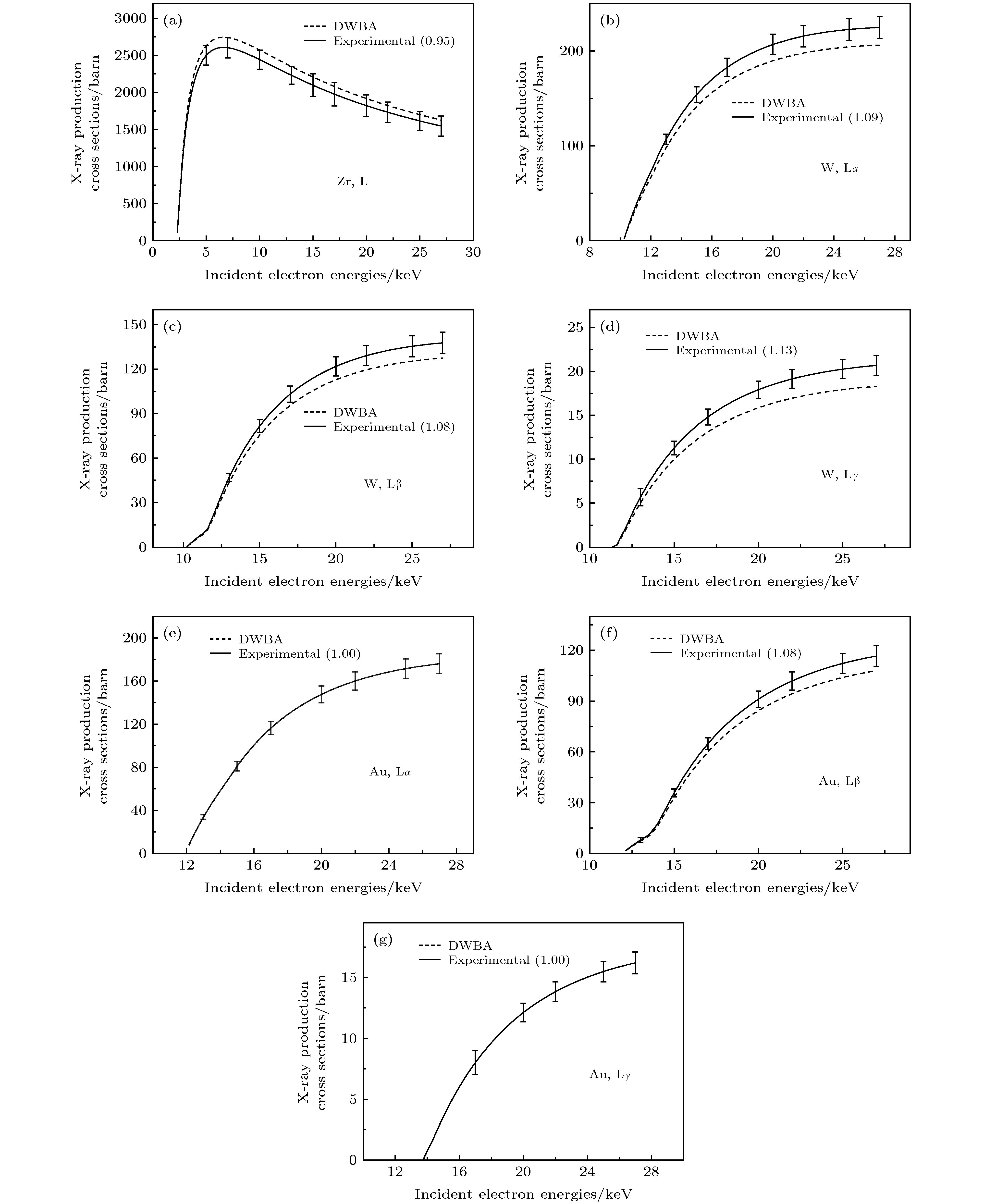-
本文使用5—27 keV能量范围的电子轰击纯厚Al (Z = 13), Ti (Z = 22), Zr (Z = 40), W (Z = 74)和Au (Z =79)靶, 利用硅漂移探测器(SDD)收集产生的X射线, 给出了K, L壳层特征X射线产额的测量结果, 并将所得实验数据与基于扭曲波玻恩近似理论模型(DWBA)的蒙特卡罗模拟值进行了比较, 两者在小于或约为10%的范围内符合. 根据测得的特征X射线产额进一步得到了相应的内壳层电离截面或特征X射线产生截面. 通过对比电子入射角度为45°和90°的两种情况下解析模型与蒙特卡罗模拟的特征X射线产额, 发现在入射角度为90°时两者符合较好. 同时, 本文还给出了次级电子、轫致辐射光子对特征X射线产额的贡献, 该贡献与入射电子能量关系较弱, 表现出与原子序数较密切的相关性.In this paper, pure thick Al (Z = 13), Ti (Z = 22), Zr (Z = 40), W (Z = 74) and Au (Z = 79) targets are bombarded by electrons in an energy range of 5–27 keV, and the experimental thick-target characteristic X-ray yields of K-shell and L-shell, the X-ray production cross sections and the ionization cross sections of inner shells are presented. The present experimental setup and data processing are improved, specifically, a deflection magnet is installed in front of the X-ray detector to prevent the backscattered electron from entering into the X-ray detector, and the bremsstrahlung background spectra calculated from PENELOPE Monte Carlo simulations are used to deduce the net peak areas. The X-ray detector used in this experiment is the XR-100SDD manufactured by Amptek Inc. with a 25 mm2 C2 ultra-thin window which can detect the low-energy x-rays down to boron Kα line (0.183 keV). Standard sources (55Fe, 57Co, 137Cs and 241Am) with an activity accuracy range of 1%–3% (k = 2), supplied by the Physikalisch-Technische Bundesanstalt, Germany (PTB), are used to perform the detector’s efficiency calibration, and in a low-energy range (< 3.3 keV) the efficiency calibration is accomplished by measuring characteristic X-ray spectra produced by 20 keV electron impacting various thickness solid targets (i.e. by the characteristic peak method). The uncertainty of the detector’s efficiency calibration obtained in this paper is ~1.6%. The experimental thick-target characteristic X-ray yield data with an uncertainty of 1.7%–6.2% are compared with the PENELOPE Monte Carlo simulations, in which the inner-shell ionization cross sections are based on the distorted-wave Born approximation (DWBA) calculations, and they are in good agreement with a difference of less than or ~10%. According to the measured thick-target characteristic x-ray yields, the K-shell ionization cross sections for Al, Ti and Zr and the L-shell X-ray production cross sections for Zr, W and Au are also obtained with an uncertainty of 5%–8% (except for Al due to large K-shell fluorescence yield uncertainty), the difference between the experimental and theoretical data is also less than or ~10%. Moreover, by comparing the thick-target characteristic X-ray yields obtained from the analytical model and the PENELOPE Monte Carlo simulations at the electrons’ incident angles of 45° and 90°, it is found that the degree of agreement between the results from the analytical model and the Monte Carlo simulations at the incident angle of 90° is better than at the incident angle of 45°. Moreover, the contributions of the secondary electrons and bremsstrahlung photons to the characteristic X-ray yield are also given based on the PENELOPE Monte Carlo simulations. As for the elements studied in this paper, for the low ionization threshold energy, the contribution of the secondary electrons is ~2%, and however, for the high ionization threshold energy, the contribution is ~10%–20%. These contributions depend weakly on the energy of the incident electrons and show that these contributions are closely correlated with atomic number.
-
Keywords:
- characteristic X-ray yields /
- atomic inner-shell ionization /
- characteristic X-ray production cross section /
- Monte Carlo simulation
[1] Powell C J 1976 Rev. Mod. Phys. 48 33
 Google Scholar
Google Scholar
[2] Salvat F, Fernández-Varea J, Sempau J 2008 PENELOPE-2008, A Code System for Monte Carlo Simulation of Electron and Photon Transport (Issy-les-Moulineau: OECD/NEA Data Bank) pp1−324
[3] Llovet X, Powell C J, Salvat F, Jablonski A 2014 J. Phys. Chem. Ref. Data 43 013102
 Google Scholar
Google Scholar
[4] An Z, Liu M T, Fu Y C, Luo Z M, Tang C H, Li C M, Zhang B H, Tang Y J 2003 Nucl. Instrum. Methods Phys. Res., Sect. B 207 268
 Google Scholar
Google Scholar
[5] Wu Y, Wang G Y, Mu Q, Zhao Q 2014 Chin. Phys. B 23 013401
 Google Scholar
Google Scholar
[6] Pérez P D, Sepúlveda A, Castellano G, Trincavelli J 2015 Phys. Rev. A 92 062708
 Google Scholar
Google Scholar
[7] Limandri S P, Vasconcellos M A Z, Hinrichs R, Trincavelli J C 2012 Phys. Rev. A 86 042701
 Google Scholar
Google Scholar
[8] An Z, Luo Z M, Tang C 2001 Nucl. Instrum. Methods Phys. Res., Sect. B 179 334
 Google Scholar
Google Scholar
[9] Khare S P, Wadehra J M 1996 Can. J. Phys. 74 376
[10] Keller S, Whelan C T, Ast H, Walters H R J, Dreizler R M 1994 Phys. Rev. A 50 3865
 Google Scholar
Google Scholar
[11] Segui S, Dingfelder M, Salvat F 2003 Phys. Rev. A 67 062710
 Google Scholar
Google Scholar
[12] Colgan J, Fontes C J, Zhang H L 2006 Phys. Rev. A 73 062711
 Google Scholar
Google Scholar
[13] Bote D, Salvat F 2008 Phys. Rev. A 77 042701
 Google Scholar
Google Scholar
[14] Long X G, Liu M T, Ho F Q, Peng X F 1990 At. Data Nucl. Data Tables 45 353
 Google Scholar
Google Scholar
[15] Liu M T, An Z, Tang C H, Luo Z M, Peng X F, Long X G 2000 At. Data Nucl. Data Tables 76 213
 Google Scholar
Google Scholar
[16] Luo Z M, An Z, He F Q, Li T H, Long X G, Peng X F 1996 J. Phys. B: At. Mol. Opt. Phys. 29 4001
 Google Scholar
Google Scholar
[17] An Z, Li T H, Wang L M, Xia X Y, Luo Z M 1996 Phys. Rev. A 54 3067
 Google Scholar
Google Scholar
[18] Wu Y, An Z, Duan Y M, Liu M T 2010 Nucl. Instrum. Methods Phys. Res., Sect. B 268 2473
 Google Scholar
Google Scholar
[19] Fernandez-Varea J M, Jahnke V, Maidana N L, Malafronte A A, Vanin V R 2014 J. Phys. B: At. Mol. Opt. Phys. 47 155201
 Google Scholar
Google Scholar
[20] Campos C S, Vasconcellos M A Z, Trincavelli J C, Segui S 2007 J. Phys. B: At. Mol. Opt. Phys. 40 3835
 Google Scholar
Google Scholar
[21] Hombourger C 1998 J. Phys. B: At. Mol. Opt. Phys. 31 3693
 Google Scholar
Google Scholar
[22] An Z, Wu Y, Liu M T, Duan Y M, Tang C H 2006 Nucl. Instrum. Methods Phys. Res., Sect. B 246 281
 Google Scholar
Google Scholar
[23] Wu Y, Liang Y, Xu M X, Yuan Y, Chang C H, Qian Z C, Wang B Y, Kuang P, Zhang P 2018 Phys. Rev. A 97 032702
 Google Scholar
Google Scholar
[24] Zhao J L, Tian L X, Li X L, An Z, Zhu J J, Liu M T 2015 Radiat. Phys. Chem. 107 47
 Google Scholar
Google Scholar
[25] Bote D, Llovet X, Salvat F 2008 J. Phys. D: Appl. Phys. 41 105304
 Google Scholar
Google Scholar
[26] Li X L, Zhao J L, Tian L X, An Z, Zhu J J, Liu M T 2014 Nucl. Instrum. Methods Phys. Res., Sect. B 333 106
 Google Scholar
Google Scholar
[27] Zhang W G, Sun H W, Zeng F Y, Mao L, Wu Q Q, Zhu J J, An Z 2012 Nucl. Instrum. Methods Phys. Res., Sect. B 275 20
 Google Scholar
Google Scholar
[28] 黄郁旋, 毛莉, 丁伟, 安竹 2016 原子核物理评论 33 45
 Google Scholar
Google Scholar
Huang Y X, Mao L, Ding W, An Z 2016 Nucl. Phys. Rev. 33 45
 Google Scholar
Google Scholar
[29] Lee S E, Hatano Y, Hara M, Matsuyama M 2020 Fusion Sci. Technol. (DOI: 10.1080/15361055.2020.1711855)
[30] Yadav N, Bhatt P, Singh R, Llovet X, Shanker R 2012 J. Electron. Spectrosc. Relat. Phenom. 185 23
 Google Scholar
Google Scholar
[31] Yadav N, Kumar S, Bhatt P, Singh R, Singh B K, Shanker R 2012 J. Electron. Spectrosc. Relat. Phenom. 185 448
 Google Scholar
Google Scholar
[32] Rubel M, Coad J P, Likonen J, Philipps V 2009 Nucl. Instrum. Methods Phys. Res., Sect. B 267 711
 Google Scholar
Google Scholar
[33] Zhao J L, An Z, Zhu J J, Tan W J, Liu M T 2016 J. Phys. B: At. Mol. Opt. Phys. 49 065205
 Google Scholar
Google Scholar
[34] Li L, An Z, Zhu J, Tan W, Sun Q, Liu M 2019 Phys. Rev. A 99 052701
 Google Scholar
Google Scholar
[35] Uzonyi I, Szabó G, Borbély-Kiss I, Kiss Á Z 2003 Nucl. Instrum. Methods Phys. Res., Sect. B 210 147
 Google Scholar
Google Scholar
[36] Shima K, Okuda M, Suzuki E, Tsubota T and Mikumo T 1983 J. Appl. Phys. 54 1202
[37] An Z, Hou Q 2008 Phys. Rev. A 77 042702
 Google Scholar
Google Scholar
[38] Omar A, Andreo P, Poludniowski G 2018 Nucl. Instrum. Methods Phys. Res., Sect. B 437 36
 Google Scholar
Google Scholar
[39] Hubbell J H, Trehan P N, Singh N, Chand B, Garg M L, Garg R R, Singh S, Puri S, Mehta D 1994 J. Phys. Chem. Ref. Data 23 339
 Google Scholar
Google Scholar
-
图 2 SDD探测器效率刻度曲线. 空心圆表示Al, Ti, Zr, W和Au的特征X射线位置, 实线表示根据探测器参数计算的效率值
Fig. 2. The X-ray detection efficiency of the SSD detector. The positions of the characteristic X-ray lines for Al, Ti, Zr, W and Au are indicated by the open circles. The solid line represents the theoretical values calculated based on the detector’s parameters.
图 5 实心圆点表示实验测得不同入射电子能量下的厚靶特征X射线产额, 实线代表相应的蒙特卡罗模拟值, 虚线为蒙特卡罗模拟值归一到实验数据值上的结果, 括号内为归一化参数, 缩略图为实验布局示意图
Fig. 5. Solid circles denote the experimental characteristic X-ray yields of thick targets at different incident electron energies. Solid curves represent the results of Monte Carlo simulations using the PENELOPE code. Dashed curves are the scaled results of Monte Carlo simulations by scaling factors that are given in parentheses. The insets show the schematic of experimental geometry.
图 6 α = 45°, β = 45°时由PENELOPE计算的特征X射线产额(实心圆点), 其中来自初级电子电离贡献表示为空心圆形, 次级电子电离贡献表示为空心三角形, 轫致辐射光子贡献为空心方形. 实线为方程(2)计算所得结果. 缩略图为计算几何示意图
Fig. 6. In the case of α = 45°, β = 45°, the solid dots represent the total characteristic X-ray yields calculated by PENELOPE, which include the contributions from the primary electron ionization (hollow circles), secondary electron ionization(hollow triangles) and bremsstrahlung photon ionization (hollow squares). The solid lines are the characteristic X-ray yields calculated by Eq. (2). The insets show the schematic of calculation geometry.
图 7 α = 0°, β = 45°时由PENELOPE计算的特征X射线产额(实心圆点), 其中来自初级电子电离贡献表示为空心圆形, 次级电子电离贡献表示为空心三角形, 轫致辐射光子贡献为空心方形. 实线为方程(2)计算所得结果. 缩略图为计算几何示意图
Fig. 7. In the case of α = 45°, β = 45°, the solid dots represent the total characteristic X-ray yields calculated by PENELOPE, which include the contributions from the primary electron ionization (hollow circles), secondary electron ionization(hollow triangles) and bremsstrahlung photon ionization (hollow squares). The solid lines are the characteristic X-ray yields calculated by Eq. (2). The insets show the schematic of calculation geometry.
-
[1] Powell C J 1976 Rev. Mod. Phys. 48 33
 Google Scholar
Google Scholar
[2] Salvat F, Fernández-Varea J, Sempau J 2008 PENELOPE-2008, A Code System for Monte Carlo Simulation of Electron and Photon Transport (Issy-les-Moulineau: OECD/NEA Data Bank) pp1−324
[3] Llovet X, Powell C J, Salvat F, Jablonski A 2014 J. Phys. Chem. Ref. Data 43 013102
 Google Scholar
Google Scholar
[4] An Z, Liu M T, Fu Y C, Luo Z M, Tang C H, Li C M, Zhang B H, Tang Y J 2003 Nucl. Instrum. Methods Phys. Res., Sect. B 207 268
 Google Scholar
Google Scholar
[5] Wu Y, Wang G Y, Mu Q, Zhao Q 2014 Chin. Phys. B 23 013401
 Google Scholar
Google Scholar
[6] Pérez P D, Sepúlveda A, Castellano G, Trincavelli J 2015 Phys. Rev. A 92 062708
 Google Scholar
Google Scholar
[7] Limandri S P, Vasconcellos M A Z, Hinrichs R, Trincavelli J C 2012 Phys. Rev. A 86 042701
 Google Scholar
Google Scholar
[8] An Z, Luo Z M, Tang C 2001 Nucl. Instrum. Methods Phys. Res., Sect. B 179 334
 Google Scholar
Google Scholar
[9] Khare S P, Wadehra J M 1996 Can. J. Phys. 74 376
[10] Keller S, Whelan C T, Ast H, Walters H R J, Dreizler R M 1994 Phys. Rev. A 50 3865
 Google Scholar
Google Scholar
[11] Segui S, Dingfelder M, Salvat F 2003 Phys. Rev. A 67 062710
 Google Scholar
Google Scholar
[12] Colgan J, Fontes C J, Zhang H L 2006 Phys. Rev. A 73 062711
 Google Scholar
Google Scholar
[13] Bote D, Salvat F 2008 Phys. Rev. A 77 042701
 Google Scholar
Google Scholar
[14] Long X G, Liu M T, Ho F Q, Peng X F 1990 At. Data Nucl. Data Tables 45 353
 Google Scholar
Google Scholar
[15] Liu M T, An Z, Tang C H, Luo Z M, Peng X F, Long X G 2000 At. Data Nucl. Data Tables 76 213
 Google Scholar
Google Scholar
[16] Luo Z M, An Z, He F Q, Li T H, Long X G, Peng X F 1996 J. Phys. B: At. Mol. Opt. Phys. 29 4001
 Google Scholar
Google Scholar
[17] An Z, Li T H, Wang L M, Xia X Y, Luo Z M 1996 Phys. Rev. A 54 3067
 Google Scholar
Google Scholar
[18] Wu Y, An Z, Duan Y M, Liu M T 2010 Nucl. Instrum. Methods Phys. Res., Sect. B 268 2473
 Google Scholar
Google Scholar
[19] Fernandez-Varea J M, Jahnke V, Maidana N L, Malafronte A A, Vanin V R 2014 J. Phys. B: At. Mol. Opt. Phys. 47 155201
 Google Scholar
Google Scholar
[20] Campos C S, Vasconcellos M A Z, Trincavelli J C, Segui S 2007 J. Phys. B: At. Mol. Opt. Phys. 40 3835
 Google Scholar
Google Scholar
[21] Hombourger C 1998 J. Phys. B: At. Mol. Opt. Phys. 31 3693
 Google Scholar
Google Scholar
[22] An Z, Wu Y, Liu M T, Duan Y M, Tang C H 2006 Nucl. Instrum. Methods Phys. Res., Sect. B 246 281
 Google Scholar
Google Scholar
[23] Wu Y, Liang Y, Xu M X, Yuan Y, Chang C H, Qian Z C, Wang B Y, Kuang P, Zhang P 2018 Phys. Rev. A 97 032702
 Google Scholar
Google Scholar
[24] Zhao J L, Tian L X, Li X L, An Z, Zhu J J, Liu M T 2015 Radiat. Phys. Chem. 107 47
 Google Scholar
Google Scholar
[25] Bote D, Llovet X, Salvat F 2008 J. Phys. D: Appl. Phys. 41 105304
 Google Scholar
Google Scholar
[26] Li X L, Zhao J L, Tian L X, An Z, Zhu J J, Liu M T 2014 Nucl. Instrum. Methods Phys. Res., Sect. B 333 106
 Google Scholar
Google Scholar
[27] Zhang W G, Sun H W, Zeng F Y, Mao L, Wu Q Q, Zhu J J, An Z 2012 Nucl. Instrum. Methods Phys. Res., Sect. B 275 20
 Google Scholar
Google Scholar
[28] 黄郁旋, 毛莉, 丁伟, 安竹 2016 原子核物理评论 33 45
 Google Scholar
Google Scholar
Huang Y X, Mao L, Ding W, An Z 2016 Nucl. Phys. Rev. 33 45
 Google Scholar
Google Scholar
[29] Lee S E, Hatano Y, Hara M, Matsuyama M 2020 Fusion Sci. Technol. (DOI: 10.1080/15361055.2020.1711855)
[30] Yadav N, Bhatt P, Singh R, Llovet X, Shanker R 2012 J. Electron. Spectrosc. Relat. Phenom. 185 23
 Google Scholar
Google Scholar
[31] Yadav N, Kumar S, Bhatt P, Singh R, Singh B K, Shanker R 2012 J. Electron. Spectrosc. Relat. Phenom. 185 448
 Google Scholar
Google Scholar
[32] Rubel M, Coad J P, Likonen J, Philipps V 2009 Nucl. Instrum. Methods Phys. Res., Sect. B 267 711
 Google Scholar
Google Scholar
[33] Zhao J L, An Z, Zhu J J, Tan W J, Liu M T 2016 J. Phys. B: At. Mol. Opt. Phys. 49 065205
 Google Scholar
Google Scholar
[34] Li L, An Z, Zhu J, Tan W, Sun Q, Liu M 2019 Phys. Rev. A 99 052701
 Google Scholar
Google Scholar
[35] Uzonyi I, Szabó G, Borbély-Kiss I, Kiss Á Z 2003 Nucl. Instrum. Methods Phys. Res., Sect. B 210 147
 Google Scholar
Google Scholar
[36] Shima K, Okuda M, Suzuki E, Tsubota T and Mikumo T 1983 J. Appl. Phys. 54 1202
[37] An Z, Hou Q 2008 Phys. Rev. A 77 042702
 Google Scholar
Google Scholar
[38] Omar A, Andreo P, Poludniowski G 2018 Nucl. Instrum. Methods Phys. Res., Sect. B 437 36
 Google Scholar
Google Scholar
[39] Hubbell J H, Trehan P N, Singh N, Chand B, Garg M L, Garg R R, Singh S, Puri S, Mehta D 1994 J. Phys. Chem. Ref. Data 23 339
 Google Scholar
Google Scholar
计量
- 文章访问数: 15948
- PDF下载量: 258
- 被引次数: 0














 下载:
下载:
